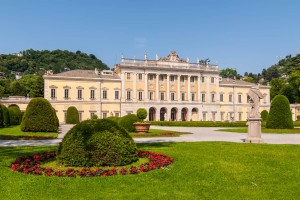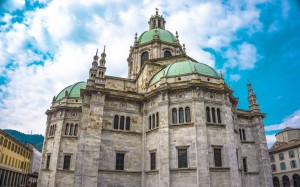Como, capital of the eponymous province in Lombardy, is situated at the southwest shore of Lake Como. This tourist town in close proximity to the Swiss border and only 45 km from Milan is genuinely stunning. It goes without saying that the lake alone is worth the visit for swimming and lots of different water sports. However, there’s many a lesser known highlight hidden behind the walls of the city of arts that is Como. Let’s learn more about them together.
Como then and now

©Bigstock.com/byvalet
It would appear that the lake and its surrounding hills have always been very popular as some finds hint at settlements as early as the 10th century BC which would thrive until a devastating Celtic raid. It is believed that Comum, to use the Roman name, was actually founded by the Gaul. The eventual Roman colony was heavily expanded and fortified under Gnaeus Pompeius Strabo and Caesar for protection against Rhaetian attacks. The lake of the once wealthy place with a flourishing iron industry used to be home to numerous villas.
Early Germanic invasions heavily affected Como with people only returning in Lombard times. A latent conflict with the archbishops o Milan resulted in a gruelling cycle of war, occupation, relief and devastation. Frequently changing rulers during the Middle Ages eventually brought Como back under Milanese rule in 1450 before the town – like the rest of Lombardy – became Spanish dominion. Later centuries saw Como fall to Austria, the Cisalpine Republic, Napoleon’s Italian kingdom, and back to Austria before Giuseppe Garibaldi freed the town in 1859 for it to become part of the new Kingdom of Italy.
Como Cathedral

©Bigstock.com/boggy
This extensively short overview – we stan oxymorons! – shows that Como’s history is everything but linear. Changing rulers and dynasties left a highly multifaceted cityscape dominated by the cathedral. Cattedrale di Santa Maria Assunta, to use its full name, is in the heart of the historic centre and was the final Gothic cathedral to be built in all of Lombardy. There actually had already been a cathedral – Santa Maria Maggiore near the lake was built in the 9th century – but the planned restoration that started in the late 14th century eventually turned into a completely new building.
You probably won’t be surprised to hear that things didn’t quite go as planned leading to several construction phases. The main apse, the sacristies and the wings were done by 1519, the south and the north apse only followed about a century later and the cupola wouldn’t be completed until the mid-18th century. Even though the construction phases extended into and far beyond the Renaissance, there’s very little to be seen of these different architectural and artistic eras. Como Cathedral is decorated with numerous grand works of arts including statues of Pliny the Elder and Pliny the Younger, both natives of Como, and astounding altarpieces. The cathedral treasury contains the reliquary shrine Urna Volpi with hairs of the Virgin Mary and a hairpin of Mary Magdalene.
Churches and castles in Como
Numerous medieval and Romanesque churches, grand palaces and castles inside and around the ancient city walls that were fortified and rebuilt in the Middle Ages give you an idea of the architectural diversity of Como. Time for a brief look at a few select religious and profane building:
- San Fedele: This late 12th century church near the cathedral might be a bit hard to find. San Fedele is nestled between residential buildings both left and right. In addition, the façade was reconstructed in 1914 for harmonious incorporation into the overall cityscape. What is interesting is the rather unusual three-conch chancel. It was likely modelled after a church in Cologne and has ever since been an object of research of possible medieval relationships between Como and the Rhine city.
- Sant’Abbondio: Like San Fedele, Sant’Abbondio is older than the cathedral. The nave was likely built during the second half of the 11th century when members of the Ottonian dynasty brought German Romanesque architecture to Como. The ornamentation and the towers were evidently modelled after various Northern European structures, the cylindrical columns likely are of French origin, and the 14th century frescoes clearly work with stylistics from Umbria and Tuscany.
- Castello Baradello: How about a neat little trip to the hill towering above the town? Castello Baradello is located where the original Roman settlement was established. It can look back at a long and astounding history, at one time restored and given to the people of Como by Barbarossa. Emperor Charles V had everything but the tower dismantled in the 16th century in order to prevent the castle from falling in hands of French troops. The extensive restoration only took place in 1971. Over all these years the tower with Byzantine walls, likely dating back to the 6th or 7th century, survived.
Other sights you have to check out
Would you like a bit more of Como? Well, duh, it’s not like we can get enough of this riveting city of arts either. Here are some additional favourites:
- Casa del Fascio: Como is not only home of fascinating witnesses of former rulers. Casa del Fascio is widely regarded as a landmark of modern Italian architecture, the so-called Razionalismo. The former seat of the local section of Mussolini’s Fascist party now houses the Guardia di Finanza and its museum.
- Villa Olmo: You are interested in neoclassical architecture? Como has got you covered as well! Marquis Innocenzo Odescalchi ordered the construction of Villa Olmo in the late 18th Later owners would make extensive alterations – the foyer was turned into a large hall, the garden into an English park – but the original spirit remained.
- Tempio Voltiano: Alessandro Volta invented the first electrical battery in 1800. This neoclassical museum was built in on the 100th anniversary of the scientist’s passing and shows various scientific tools, early voltaic piles, and personal belongings from Volta’s life.
- Funicular: Brunate is situated on a hill above Como. The area was populated as far back as the 4th century BC and turned into a popular tourist destination after the Second World War. As such, the funicular mono-railway that connects Como and Brunate evolved from being the main mode of transportation for locals into a popular tourist attraction.
- Broletto: And finally, we take a trip back into the Middle Ages. The most important medieval secular building of city is situated just northwest of the cathedral façade, a clear sign of the era’s close connection between religious and secular power. Mason pillar arcades lead into the building adorned with numerous figurines, balustrades and loggias.
While Como might be one of the lesser known cities of arts, it is still worth a visit, not just because of Lake Como. You will discover many a hidden gem from the town’s ancient roots to the very distinct medieval heritage to the eventful later periods and the modern era. Oh, by the way, don’t forget to jump into the lake in summer!